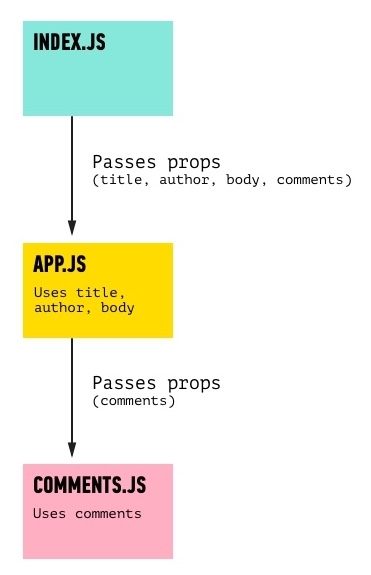Nested Components
Learning Objectives
After this lesson, you will be able to:
Diagram nested components
Render components within another component
Pass props to a nested component

We Do: Nested Components
In your blog, a section of your App.js render function currently looks like this:
While you can certainly display more comments with <p>{this.props.comments[1]}</p>, <p>{this.props.comments[2]}</p>, etc, do you think this is the best way?
It would be a pain to have to explicitly define every comment when rendering <Post />, especially if each comment had multiple properties.
This problem is a telltale sign that our separation of concerns is being stretched, and it's time to break things into a new component.
To solve this problem, in the following slides we will nest Comment components within a Post component.
We can create these comments the same way we created posts: By defining a Comment class that extends Component and has a render method.
Next, we'll put comments inside an individual post component. To do this, we can reference a comment using <Comment /> inside of Post's render method.
Starting from the blog post code, let's create a new file for a
Commentcomponent,src/Comment.js:
What have we done?
We've defined our component class, which inherits from
React.Component.We're exporting this
Commentclass by default for anything importing this file.We are returning JSX that contains a paragraph displaying a
bodyprop (which will be passed in).
Now, in src/App.js, we need to import our Comment component so it's available to the Post component class.
Change the top of
App.jsto include the new class:
With this setup, we can render one or more comments inside the Post component. Currently, <p>{this.props.comments[0]}</p> is rendering one comment in the Post component from App.js. Now, instead of this line, we'll want to render a Comment component (which renders a paragraph with the comments, so it will look the same!).
Edit that line to render a comment instead of directly rendering a paragraph. Make sure you send through the
bodyprop that theCommentcomponent class needs:
Let's reflect on what just happened. We rendered a component inside another component. Technically, we just nested components. Very much like how we imported Post from App.js into index.js and rendered a post inside index.js, we've imported Comment from Comment.js into App.js and rendered a comment. Inside App.js, we're using some of the props to render a post and simply passing the comments prop on to be rendered with the Comment component class. So the flow of the props looks like this:

To get a little more advanced...
That's nested components! What we're about to look into is just the idea of calling an object during the render return method - and that object can have component calls in it.
What we did:
<Comment body={this.props.comments[0]} /> passed just the first object in the comments array
What we can do:
We can also simply pass a variable as a parameter. For example, we could pass the whole comments array with <Comment body={comments} />. We can also just write a JavaScript expression if we put it inside brackets. For example, if I had an object inside my App.js, each row of the object could individually call the Comment component.
Following along here is optional! This is to demonstrate a shorthand way of writing what your code already does.
Why is this variable declared in the
rendermethod? Because this calls theCommentcomponent, which will render UI within it. Therendermethod is where all UI goes!
We could call then call this object inside our return JSX with {allComments}, which would then call all three of those <Comment /> statements:
Note: We could have put all of our code in one file, but it's a good practice to break components out into different files to help practice separation of concerns. The only downside is that we have to be extra conscious of remembering to export / import each component to the file where it's rendered.
Last updated
Was this helpful?